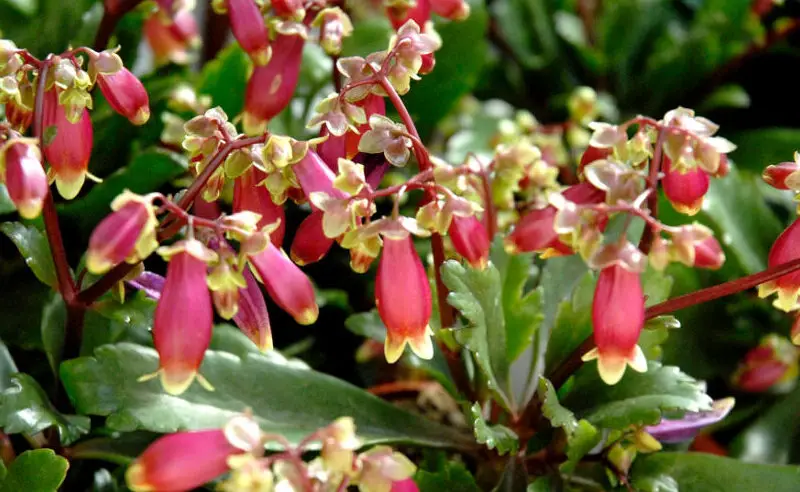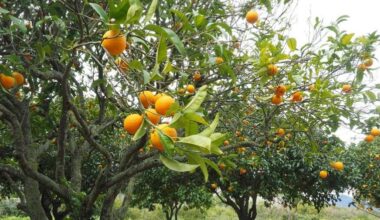Easy to live with and very floriferous, the florist’s kalanchoe comes in many varieties with single or double flowers in bright colors. Whether outdoors in the mildest regions or at home anywhere else, it will be your companion for many years.
Contents
Care of the Kalanchoe outdoors
The Kalanchoe does not like too much water. Water it sparingly. 1 to 2 times a fortnight when not in bloom and 1 to 2 times a week when in bloom. Too much water will eventually break it, as it will grow too fast and not be strong enough. Let the soil dry partially between waterings.
In winter, some species grown mainly for their foliage need to be rested in a place with a temperature between 44 and 55 °F maximum. Water lightly to prevent the soil from becoming too dry, during this period (1 or 2 waterings per month).
In spring and summer, add liquid fertilizer for flowering plants about once a month.
After the frosts and thinking all summer, you can take your pot outside in the sun on a windowsill, on a bacon or in the garden. You can even bury it, if you have the possibility. This will encourage new growth and strengthen your kalanchoe.
Be sure to repot it every 2 years before it gets too small in its pot and before its resting period which is from November to January.
The pot
Prefer a terracotta pot to promote water evaporation and gas exchange. Don’t forget that the pot must be pierced at the bottom and lined with a drainage bed made of small gravel or pebbles.
This succulent plant does not tolerate residual moisture at the root level, so do not use clay balls which retain too much moisture.
The repotting takes place in spring, as soon as the roots are cramped.
The substrate
The substrate must be well drained too. A mixture of good potting soil and river sand of average granulometry will be perfectly suitable.
The exposure
A very strong luminosity will ensure you a beautiful bloom. The plant can even be exposed to morning and evening sunlight without worrying, on the contrary.
As soon as the temperatures allow it in late spring, place your kalanchoe outside, it will do even better. Remember to bring it inside before the first cold weather to preserve it.
Temperature
This plant likes temperatures between 60 and 82°F. It is not rustic and fears frost. The foliage is marked as soon as the temperature drops below 50°F.
Watering
Like all succulents, the Kalanchoe can withstand a lack of watering better than too much. This is especially true in winter, when you should wait for the substrate to dry out completely before watering again. Never leave water in the cup.
During the summer season, add fertilizer for flowering plants about every 3 weeks after a heavy watering.
Pruning
Cut off spent flowers to prevent them from rotting and damaging the foliage. New flower buds should soon form!
Re-blooming your kalanchoe outdoors
The main problem with the kalanchoe is excess water, which causes the roots to rot. If the leaves at the base rot, you are in this situation: reduce watering.
On the other hand, if its rather thick and fleshy leaves wither and sag, the plant is lacking water (it needs it especially during its flowering period).
From February to April
During flowering, water about twice a week. Fertilize with liquid fertilizer every 15 days, and place the pot just behind a window.
From May to September
If you can, place the pot outside in the sun. A corner available in the garden? Bury it! The plant will come out stronger (and with new shoots).
If you don’t have a garden, a windowsill sheltered from the wind and in the sun will suit it very well.
In October
Repot in a rich and light soil (a lot of sand and little peat, which fixes the humidity).
Take advantage of this operation to take cuttings to place in the same mixture: the operation is very easy!
From November to January
This is the resting period, necessary for a beautiful flowering. Reduce watering, stop fertilizing and, if possible, lower the temperature (cool room, around 59°F).
Pruning the Kalanchoe outdoors
No pruning is necessary. However, if the shoots of some Kalanchoe plants are getting longer, you can pinch them off to strengthen their growth (you can then take cuttings from the cut parts).
Remove dead, dry or damaged flowers and leaves regularly.
Diseases and pests of the kalanchoe outdoors
Poor watering of the kalanchoe can lead to the development of diseases. Excessive humidity can cause mildew and blackening of the leaves.
On the other hand, too much dryness (or a cold plant) will cause the leaves to dry out and fall off.
A Blossfeld’s kalanchoe (Kalanchoe blossfeldiana) that lacks light is noticeable by its pale green foliage and elongated stems.
Mealy bugs, which can be seen as small woolly patches on the leaves or roots, can parasitize the kalanchoe. Dab them off with a cotton ball soaked in denatured alcohol or an anti-cochineal product available at your garden center.
Species and varieties of kalanchoe
There are more than 100 species in the Kalanchoe genus. The best-known of these is the Kalanchoe, which flowers abundantly and lasts a long time, but there are others that deserve a place in our homes and conservatories because of their beautiful foliage.
Kalanchoe blossfeldiana or Blossfeld’s Kalanchoe
This is the most popular kalanchoe. From 12 to 17 inches tall in all directions, it bears glossy, rounded, fleshy dark green leaves with serrated edges. It blooms for 2 to 3 months offering tight clusters of red, orange, yellow, white or pink tubular florets.
Although it usually blooms in spring, this flowering kalanchoe can be found for sale all year round. It can be stored after flowering, so don’t throw it away! The new “Queen” variety is made up of several very bright colors, some of them even two-tone.
Kalanchoe calandiva
This is a natural mutation of the Blossfeld Kalanchoe. Instead of single flowers with four petals, its flowers are double with a small rosette of 32 petals. There are different colors of this double kalanchoe.
Kalanchoe behariensis or Elephant Ear Kalanchoe (or Behara)
If it reaches more than 3 m in its natural Madagascan environment, this small tree of slow growth with an upright bearing culminates at 1 m in pot. Its very decorative leaves are long and triangular. Grey or light brown, they are covered with a fine down. The plant blooms when mature, but rarely indoors.
Kalanchoe pumila
This small, creeping kalanchoe, 8 to 12 inches tall, is great for hanging baskets. Its oval, toothed leaves are green and nicely tinted with white bloom. The plant blooms in late winter in loose clusters of pink-purple flowers.
Kalanchoe tubiflora or candlestick plant
This upright plant reaches 10 to 12 inches in height. It has 6 inch long, cylindrical, gray-green leaves marked with reddish-brown. The orange-red hanging tubular flowers are grouped in panicles.
Kalanchoe thyrsiflora
This South African species is appreciated for its flared silhouette forming a rosette with large rounded pale green leaves tinged with red on the edges. The young shoots are bright red. The plant blooms in spring offering bouquets of yellow tubular florets delicately perfumed.









